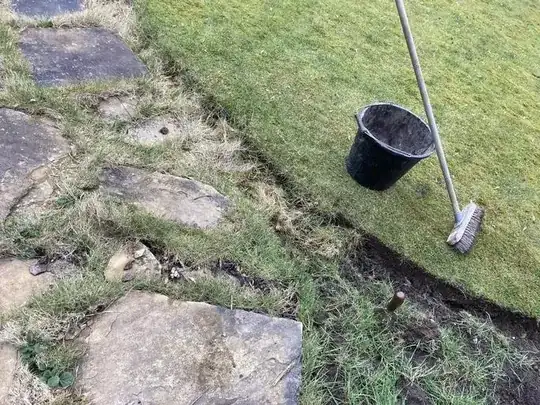There is no one "right way" to create and maintain a crisp lawn edge.
When I was much younger than I am now, I did exactly what you are doing, except I used a flat spade to cut the edge and a trowel to clean it up. I did do one thing differently: I removed all grass cut from the edge from the garden, after knocking the soil off - it tends to root into the garden if you don't do that.
I would do this every spring for over 30 linear meters of garden. And then I got older and this became too much work. I also had a neighbor fall into the trench I'd created; she nearly sprained her ankle.
If you don't want to do this trenching annually, then you have to look at some kind of edging product. Note that I'm in the US, so the products I mention may not be available in the UK.
Bricks
Pros:
- Permanent installation.
- If placed vertically, their depth really keeps the grass roots from growing under the bricks and into the garden.
- Easy to maintain the edge because your lawnmower wheels can ride on
top of the bricks, not the soil.
- Could be relatively inexpensive, depending on your source. If you haunt a building demolition project, you might even get them for free.
- The trench you've already made will make installation pretty easy - just dig it a bit deeper and give it a flat bottom. Level the height with sand and place the bricks.
Cons:
- Can move both vertically and, especially, horizontally due to frost heaving
- If placed horizontally (especially wide side up), then grass roots will grow underneath the bricks, making them ineffective at maintaining a neat edge
- Grass roots will take advantage of the gaps between the bricks and enter the garden.
Bullet-nose Pavers
Pros:
- Permanent installation and unlikely to move via frost-heaving.
- Taller pavers act like vertical bricks to keep grass roots out of the garden.
- Easy to maintain the edge because your lawnmower wheels can ride on
top of the pavers.
- The trench you've already made will make installation pretty easy - like with bricks, just give it a flat bottom. Level the height with sand and place the pavers.
- The interlocking nature of the pavers makes it easier and neater to make curves.
Cons:
- Grass roots will take advantage of the gaps between the bricks and enter the garden, although the interlock will make this more difficult for the roots.
- Roots trying to get between the pavers will make the top look untidy (grass will grow between the pavers). You must therefore weed your edge occasionally to keep the edge clean.
- Not all bullet-nose pavers are equal. In the US, some large stores sell pavers that are only 5-7cm high. This is too shallow to prevent roots of most lawn grasses from growing under them.
Metal Edging
Really the gold-standard for edging products.
Pros:
- These products give a beautiful, professional edge.
- Permanent installation and, if installed properly, unlikely to move due to frost heave.
- Depth is usually at least about 9.5cm (4in), so able to keep nearly all grass roots out of the garden.
- The trench you've already made will make installation easy. If it's not 9.5cm already, deepen it, then place the edgers and stake.
Cons:
The edging is by far the most expensive product you can use.
The metal panels usually contain holders for the stakes that are
punched from the panel rather than braised on as a separate
piece. This allows grass roots to easily infiltrate through the
edging and into the garden. You should use a small piece of aluminium
flashing on the lawn-side of the panel to prevent this. No dealer
tells you this, by the way.
Because these are staked vertically, you can sink the edging below the level of the lawn if/when you step on the edging while working in the garden (especially in spring or after a rain). This require you to either periodically lower the edge of the lawn or raise the edging if you want to maintain the clean line.
Plastic Edging
By far the most common edging in the US, due to cost. The best edging is purchased in the US as 20 ft straight "sticks", although most consumers go for the flimsy (and crappy) coiled edging sold in boxes.
Pros:
- Cheap - maybe only $2/linear foot (not sure what the price in the UK is)
- If rolled edge (the large plastic cylinder at the top), staking is done horizontally and if properly installed, the edging will never frost-heave. If straight-edged staking is vertically so there is a minor possibility of frost-heave
- if you know how to properly join two pieces of edging, there is no gap between two "sticks" of edging
- The height is comparable to metal edging, so it does a great job keeping grass out of the garden.
- For rolled-edge plastic, there are no openings in the edging for staking.
Cons:
- Edging purchased coiled in boxes has a "memory" and will never allow
you to create a straight line without kinking. Even creating nice
looking curves can be difficult.
- If rolled-edge plastic, then the edge created may not be as crisp as you'd like.
- If straight-edged plastic, then there typically are openings for
stakes which lead to grass infiltration.
Recycled Plastic
I have no direct experience with this product, but it resembles metal edging or straight-edged plastic edging in looks. I suspect that it is installed very much like metal edging, with vertical staking. Keeping it gap-free between sections may be an issue, although some systems I've seen use recycled-plastic pieces that slip onto each edge of the adjacent panels to connect them. If vertically staked, frost-heave and sinking-due-to-stepping may be issues as they are with metal edging.

